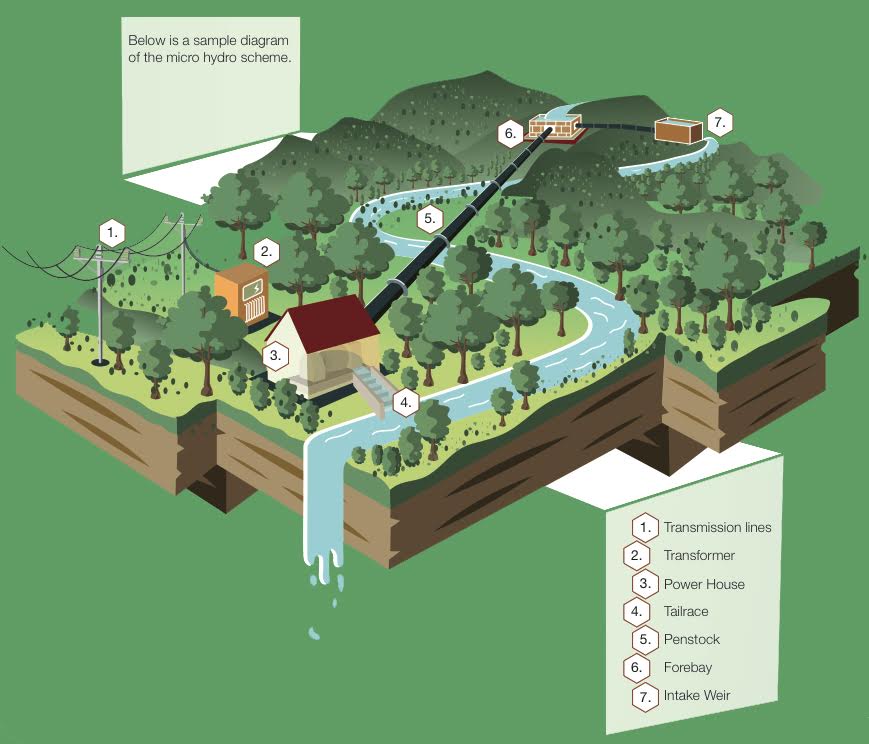By: Collin Thomas, Associate Board Member, Green Empowerment
Electricity is fundamental to functioning health care and economic opportunity. Yet, globally, it is estimated that over 700 million people lack access to electricity. In addition, many people reside in remote locations without modern communications or transportation infrastructure. For these “last-mile” communities, developing reliable electricity access can fundamentally change their prospect for health, education and economic opportunity.
Rural Electrification at the Last-Mile
Renewable energy mini-grids are a promising solution to last-mile electrification. As one of the more affordable technologies for small-scale systems, micro-hydro has been demonstrated to be a clean, reliable resource for providing electricity access for last-mile communities.

Constructed of relatively inexpensive materials, micro-hydro projects can be deployed economically even in challenging locations. The technology and design principles are relatively simple. Water is diverted from a stream down a water conveyance system (typically a pipe or channel) into a concrete forebay. Water accumulates in the forebay, and any sediment settles to the bottom. From the forebay, water travels downward via the penstock through a turbine which provides power the generator can convert into electrical energy. Power is then transmitted across a transmission system to the community, and the water is returned to the river. The equipment is constructed primarily of steel, concrete, and sometimes other types of piping materials, such as PVC, making the systems economical and relatively easy to procure.
The simplicity of the design enables local community members to become trained in servicing the systems. Although there are often obstacles to installing systems in remote locations with limited or seasonal road access, the specific materials used to construct the projects can be tailored to fit the challenges. As a result, communities have proven to be incredibly resourceful in finding solutions to the most difficult of problems.

Supporting a Sustainable Future
Without alternative options for electricity, many rural villages rely on diesel-fueled generators to serve lighting and other primary electrical loads. But diesel generators come with a host of problems. Fuel is costly and must be transported to the communities. In addition, when running, the generators produce noise and harmful exhaust fumes. For all those reasons, diesel generators are run selectively, and electricity is only available on a limited and sporadic basis.
Micro-hydro solutions can relieve all of these problems. For example, in Long Tanid, a small village in Malaysian Borneo, Green Empowerment and our long-time partner TONIBUNG worked with community members to install a micro-hydro system. The project was supported by Seacology, a funder focused on community-led conservation, in exchange for the community’s commitment to protect 1,379 acres of highly biodiverse rainforests within Long Tanid’s watershed. The project was installed in 2022 and now provides 11.6kW of 24/7 power to 54 households in the community. The system is administered by a community-elected energy committee that established a tariff structure to fund the costs of maintaining the project.
Community-Owned & Operated
Community members assigned as system operators have been trained to perform regular maintenance on the equipment, and their work is paid for by funds collected from users. The project was envisioned with community involvement. It produces electricity for the benefit of the community and is administered, maintained, and funded by community members. This circular approach ensures broad buy-in for the project and that all the project’s benefits are received by those who have invested their time, money, and resources to bring it to fruition.
With the project installed, community members are paying roughly half the cost for electricity compared to buying diesel fuel and have access to electricity without toxic fumes or noise and with little interruption. While those benefits alone are significant, the second-order impacts have also contributed to the quality of life in the community. Recognizing the organizing capacity of the community, the local government supported their efforts by contributing an internet router, which now provides the village with free, 24/7 internet access. This internet access, coupled with money saved, has allowed families to invest in and gain better access to education. It has also allowed people to invest in small businesses and communicate more frequently with family members who have moved to the cities.
Scaling Up
The value of micro-hydro projects, especially in last-mile communities like Long Tanid, are enormous. While it is extremely important for new projects to be approached in a community-oriented way and in partnership with local organizations, there is still an opportunity to pursue scale. Green Empowerment and partners established the Sabah Roadmap Project in Malaysia to harness data and collaborate with the government to achieve 100% rural electrification without adding pressure to the environment. The project will electrify 203 villages in Sabah in the next 10 years, an acceleration in development powered by coalition building.
Developing electricity access for last-mile communities is a challenging endeavor. Finding solutions requires community engagement and emphasizing simple, executable design concepts. Micro-hydro projects can fit the bill in many situations, providing enormous benefits for many years to come.

Collin Thomas is a member of the Green Empowerment Associate Board. He has spent the majority of his career working in the renewable energy industry, currently working for Triple Oak Power developing large-scale wind and other renewable energy projects. He and his wife live in Carson City, Nevada with their two dogs.

[…] by the community to generate better, more sustainable outcomes. Two recent projects include a micro-hydro energy generation system we helped install in Malaysia and an ice-making facility in Peru. Janathkshan has been an indispensable project lead, recognizing […]
Hi, can you share more about the project in Malaysia. Interested to explore this as an option for a farm. Thanks.
Hi Kerry, thanks for the question. You can read some more details about the Long Tanid micro-hydro project here: https://greenempowerment.org/wp-content/uploads/2023/08/Malaysia_Impact-Report-2023_TONIBUNG_Green-Empowerment.pdf